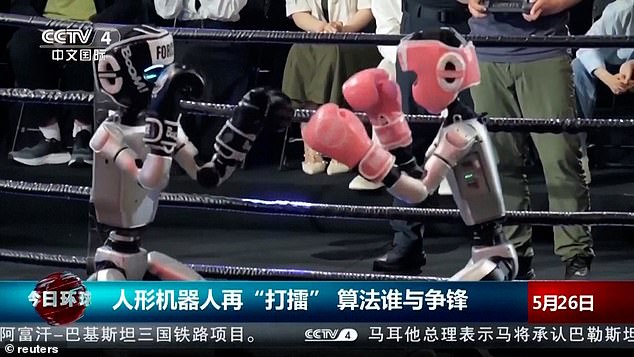
The Future of Boxing? World’s First Humanoid Robot Brawl in China
In a bold step toward blending robotics and sports, Hangzhou, China, recently hosted the world’s first humanoid robot boxing tournament. This glimpse into the future showcased two 4.3ft-tall (132cm), 35kg bipedal robots—roughly the size of an eight-year-old—trading punches and kicks in an electrifying match. The event, streamed globally, offered a mix of amusement and awe as the robots navigated a Robot Wars-style showdown.
The Fight of the Future
Clad in boxing gloves and headgear, the Unitree G1 robots—developed by Hangzhou-based Unitree Robotics—struggled initially to locate each other but soon unleashed jabs, spin kicks, and dramatic recoveries after falls. Controlled remotely by human operators, the bots showcased agility with a top speed of 2m/s (5mph) and the ability to carry up to 3kg.
The crowd cheered as the machines demonstrated striking coordination, with commentators dubbing it a “historic moment” for robotics. Chen Xiyun, a Unitree spokesperson, highlighted their repertoire: “straight punches, hooks, sidekicks, and aerial spin kicks.”
IMAGE 1
Caption: Two G1 robots spar in a ring during the pioneering humanoid robot boxing tournament in Hangzhou.
Tech Specs & Public Reaction
Priced at $16,000, the G1 robot weighs 35kg, stands 4.3ft tall, and operates via a remote controller. Beyond boxing, it can perform tasks like object manipulation and waving. However, critiques noted its current limitations—though still impressive, the clunky movements and reliance on human operators left room for growth.
IMAGE 2
Caption: A G1 robot demonstrates its mobility, balancing punches while maintaining stability.
Online reactions were mixed. Some called the event “adorable” and a “cool milestone,” while others imagined futuristic upgrades: “In five years, with tech advancements, this will look primitive!” A viewer noted, “Including kicks is impressive, even if remote-controlled.”
Beyond the Ring: AI in Combat Sports
While the event entertained, it signals a deeper shift. China’s state media emphasized the use of domestic technology, hinting at broader applications in robotics. Unitree plans to expand the league, with a full-scale humanoid combat tournament scheduled in Shenzhen later this year.
IMAGE 3
Caption: The G1’s design (left) compared to Boston Dynamics’ Spot robot dog (right).
Competing in the Robotics Race
Unitree, known for its consumer-focused robots, also markets the Go2 robot dog—a $1,600 rival to Boston Dynamics’ $75,000 Spot. While Spot targets industrial use, Unitree prioritizes affordability, integrating features like dance routines and interactive gestures. Yet, questions linger about the G1’s practicality. Its small size limits industrial roles, but its AI-driven potential suggests future adaptability.
IMAGE 4
Caption: The Go2 robot dog performing agile maneuvers, showcasing Unitree’s consumer-friendly tech.
What’s Next?
As humanoid robots evolve, blending AI autonomy with physical precision could revolutionize entertainment and labor. While today’s bouts resemble awkward first steps, advancements in sensors, balance, and AI promise faster, more dynamic matches. Combined with breakthroughs like Japan’s lab-grown “living skin” for robots, the line between machine and human grows finer.
For now, the G1’s boxing debut stands as a quirky yet groundbreaking leap—one that hints at a future where robots may dominate not just factories, but sports arenas.
Specs of Unitree G1:
- Height: 4.3ft | Weight: 35kg | Speed: 5mph
- Price: $16,000 | Battery: Lithium | Control: Remote-operated
Final Image
Caption: A G1 robot waves to spectators, highlighting its interactive capabilities beyond combat.
(Word count: ~600)


